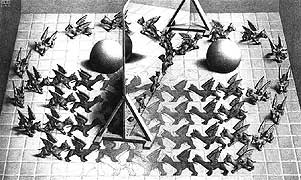
WAVEFRONT Issue Winter 1985
In the first half of this essay (Vol. 1, No. 1), I suggested that holographic art (in its first two decades) was overdetermined by scientific precedent and featured a dominant concern for the empirical verification of such things as diffraction efficiency, image size and depth, noise and the representation of 'generic subjects'. These introductory arguments presented the view that scientific-display holography and art holography could be differentiated on the basis of intent and cultural theory.
Scientific discovery is indispensable to the development of holographic imaging techniques and technology. However, science and empirical knowledge are less than useful as theories of aesthetic expression and knowledge, for empiricism is predisposed to logic and mathematical ordering, and scientific 'truth' is based on the logical correlation between the theory that predicts and the event that is observed. Such theories of 'law and order' are precisely those which were rejected in avant-garde art (Soviet Futurism, Formalism, etc.) in favor of poetic, aleatory, metaphoric and anti- grammatical i anti-symbolic formulations. It is these clearly established precedents (and their wider cultural implications) that make it imperative that we develop a "theory of avant-garde holography" or simply a "theory of art holography" on the basis of differentiation and affirmation of important aesthetic operating principles.
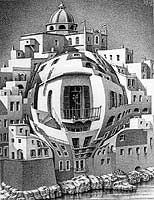
5. Theoretical Distinctions
Within holography the absence of clear aesthetic theories has led to the unfortunate conflation of technical-display theories (based on the scientific interest in optimizing diffraction efficiency) with aesthetic interests. This conflation has promoted the notion that 'high quality displays' are synonymous with 'art' and that artistic/curatorial subjectivity is the cultural qualifying ingredient. It is therefore not surprising that many of the early (and current!) catalogue descriptions were dominated by near subjective- mystical utterances (on the part of the artists) combined with the usual technical explanation/prologue (always beginning with Gabor) that sought to combine art & technology as a unique and future medium of near-idealized (eg. 'revolutionary') proportions.
A theory usually describes the "how" and "what" of a phenomenon and identifies relational characteristics existing between things, people, events, societies or symbolic representations (as in mathematics). It does not necessarily explain "why" these things happen or why these relationships ultimately exist. A theory is either relatively useful or useless depending on what it chooses to acknowledge, what it excludes and whether new 'data' confirms or contradicts its primary hypotheses and axioms. Generally speaking, a theory features the absence of internal contradictions and is such that its description of observable phenomenon does not contradict that which can be observed. A holographic theory such as "holographic art is produced by ghosts" may be disproved or challenged on a variety of levels (production, the impossibility to verify the presence of ghosts, et=) and may be deemed useless. An empirical theory of art, such as "holographic art is a practice that results in bright and noise-less three dimensional images which can be viewed without glasses" is useful insofar as it identifies physical laws, optical geometry, photo chemistry and diffraction theory, and verifies its theoretical propositions on the basis of prescribed techniques and predicted examples (such as dichromate pendants, transmission and reflection hologra ms, diffraction gratings, etc.) This theory is generally useless when the "how" and the "what" include questions of emotion and affect, iconicity and representation, cultural involvement in language and form, perceptual awareness on the part of the artist/producer and viewer, intuition and unconscious gesture, social and political context for the production and viewing of the art, and any number of perceptual experiential questions arising on the basis of identifying varied responses to the same image.
I am not proposing that science be differentiated from art on the basis of 'observable' versus 'intuitive' characteristics. The aesthetic theories of art are accountable to the 'real' of a world of social and cultural processes, to economic as well as political formations, to the 'real' of the art object-experience occupying a place and a time. (We may also note that scientific development also involves the intuitive and the inferential.) But aesthetic theories feature a propensity to cross over disciplines (since humanity itself is 'interdisciplinary') and as such must be considered as hybrids that encourage constant revision/redefinition.
Some aesthetic theories are developed strictly on the basis of a subjective stand taken by the artist or curator. In this case, the theory is generally unaccountable to the social and rarely does it theorize about (or prescribe for) the social. (The exceptions being when the artist assumes a kind of omniscient persona and publishes his 'mein kampf'.) Aesthetic theories which account for the functionings of an autonomous 'self' (a 'genius') are only useful if they ultimately feed into the developing theories of social aesthetics by providing diversity and plurality of views within an otherwise ambiguous, if not abstract and monolithic, conception of culture and art. The greatest danger in subjective aesthetics lies in the privileging of the 'personal' over the social, hence constituting a hierarchical relationship of domination/subordination, a binary of oppositions within a hierarchical axis, which speaks metaphysics and idealism all the while it pretends to defend 'freedom' of expression. The problem with subjectivism and its metaphysical oppositionalism to social norms is that social change can only occur when the social register is invoked through language or shared symbologies, only when the 'real' becomes partner with the subjective. Otherwise, the theory of aesthetic subjectivity might as well be a theory of aesthetic 'ghosts' (and their supernatural).
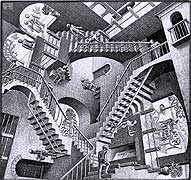
5.1 The Strange Marriage of Knowledge and Fantasy and/or Vision
The marriage of science-technology to metaphysical subjectivity-aesthetics is indeed a strange occurrence, especially if one considers the magnitude of the inherent theoretical contradictions or the absurdity of the resulting synthesis. Scientific knowledge, dedicated to observation and verification of laws and logical descriptors, finds itself in a strange bed with a practice that privileges the autonomous self as if it was the oracle of unattainable and unalterable (a priori) 'truth'. I am thinking primarily of examples which feature (on the part of the artist) a propensity towards invoking the mystical, all the while demonstrating this invocation, as perceived art form, within the scientific-technical vocabulary of display holography. I would suggest that this kind of arrangement is possible when neither partner (the scientist, or the metaphysician - sometimes one and the same person) is conscious of the nature of the relationship, except perhaps at the purely formal (surface) level where substantive questions are ignored in favor of 'technique'. Within this theoretical 'bedroom' the absence of critical content makes all kinds of formal guises possible with the net result that the resulting synthesis is informed primarily by what is least important (the form) at the expense of what is most important (the content and its relationship to the social 'real'). Here, if we are to use holography as an example, we might see the physical fact of laser light celebrated as if it were the 'light of the muses', here we might also see "Laserium", and its hallucinated 'real'.
The most challenging metaphysics which is peculiar to holography and represents an outgrowth of "new physics" is that which is termed (by Unterseher and Schlesinger in "The Holography Handbook") as "holocosmology". This theory describes the conjuncture of matter and energy on the basis of quantum and wave mechanics (and diffraction theory) and, more importantly, assigns to holography certain universal equivalents and identities ("the universe operates holographically" p. 363.) No one, except Newton, would argue against quantum/wave physics, but we have every right to question such statements as "energy interacts with constructive and destructive interference to form holograms which we perceive as matter" (p. 363, my emphasis.) And while these theoretical assertions test the limits of physics and knowledge (and their hypothetical nature is fully acknowledged by the authors), they nevertheless provide a basis wherein a 'theory of holographic art' could be developed on the assumptions (or beliefs) that holographic art articulates aspects of this supposed 'holo-cosmic reality' (and its relativity, space-time continuum, singularity, multi stability, black holes and various nodal/anti-nodal phenomenons).
Whether this is sheer fantasy or 'visionary' physics depends on the reader's 'belief' in universal symmetries, an invisible and coherent "reference wave", the notion of uniformity and steady state and, more importantly, the belief that astro-physical phenomenon can be successfully identif fed (not by mere analogy, but identity) with optical holography. For the purposes of this essay, I choose to disagree with the terms of this analogy as it is posited (and my reasons will be discussed later).
5.2 The Dual Culture Model (Plus One!)

Within our developing theoretical inquiry, questions of difference and intent remain. In the scientif ic culture(s) we have a noted predisposition to a kind of grammar (a body of rules which governs procedures and differentiates between what is relevant ('in the language') as opposed to what is irrelevant ('outside of the language'). In contra-distinction to the grammatical, aesthetic cultures feature a predisposition to a repertoire of texts (audio, visual, linguistic, gestural, etc.) I would emphasize for the reader that these grammatical and textual cultural models are not presented as something in binary opposition, nor are they descriptive of all formations. They do, however, further our inquiry into social aesthetics.
The distinctions arising in a "grammatically oriented" and a "textually oriented" culture(s) ware set out by Juri Lotman, a semiotic-linguist in 1969 and pertained to his studies as to how different societies communicate. Another semiotician, Umberto Eco (writing in "A Theory of Semiotics" - pp. 137-139) summarizes Lotman's position as follows:
"In the former (grammatical) category texts are generated by combinations of discrete units and are judged correct or incorrect according to their conformity to the combinational rules; in the latter category society directly generates texts, these constituting macro-units from which rules could eventually be inferred, but that first and foremost propose models to be followed and imitated."
Eco, summarizing Lotman, says that text-oriented societies (and I propose that the artistic society is text- oriented) are "expression oriented ones" while grammar oriented societies (which I suggest are scientific) are "content-oriented". If we approve of this model and identities, we might see where the artistic orientation towards expression (the formal register) would find its complement in the scientific orientation towards content (the substantive register). It is important to note that form and content are NOT separable in the sense that you can have a form totally without content, and vice versa. It is more satisfactory to posit 'orientation' (emphasis).
The relationship between these two 'societies', as a problem on aesthetics and semiotics, is motivated by that which each has and that which each lacks: namely, the artistic society has a repertoire of expression-oriented texts which emphasize 'form' over content; conversely, the scientific society has grammatically limited expression and an emphasis on content. The merging or partial collaboration between these two societies produces what might be termed mutually beneficial results, in that both participate in an 'exchange' that provides the scientific with expression possibilities and the artistic with logico-mathematical content. This exchange does not fundamentally alter the theoretical or cultural predispositions of either social system but provides added avenues for interaction and growth (the developing lexicon). But there is something missing here, and I am sure that the reader must have noticed that these models pertain very much to a kind of 'fundamental' division, which is largely indicative of earlier cultures (tribal, religious, feudal, intellectual, and early scientific), a lacking which requires augmentation by the introduction of at least another term, the 'techno-artistic', to be useful for our present day purposes.
5.21 "The Hologrammatical Society"
In light of the "holocosmology" identified earlier in 5.1, it is possible to posit a third socio-cultural term which I will call the "Hologrammatical Society" since it conforms, in part, to a separate and distinct entity which is based on the fusion of a new conception of physics and a new conception of aesthetic text making. It is 'holistic' in the sense that it views all undertakings as representing universal correlations (and by that we may assume that its ethics and morality are reflecting universal order); it features the conjuncture of the theory of physical (space-time) relativity with ethical relativism, and more importantly grounds itself in a conception of "universal symmetries" and "universal harmonics" (geometry as grammatically formulated). This culture, and we may reflect on one of its strongholds - the New York and San Francisco 'connection' as addressed in the Unterseher-Schlesinger text pp. 338- 343 - makes claim for holography as "the most revolutionary-medium (Jackson) which makes possible for one to create "one's own space...for the first time" (altering perception, conception and creating "new spaces") whereby "the imagination can become a domain of time and space in which the relationships of objective reality become plastic" (Bush), and where "it is possible to create a fabric of reality containing patches of another reality (whereby our normal perception is) crammed with other universes that we do not normally deal with" (Schweitzer).
These assertions, collectively, embody the notion of a transcendental register which is exemplified through the aestheticization and representation of holographic mappings of wavefront reconstruction. The arguments assert that a paradigmatic shift has occurred with the invention of holography, a shift from the earlier "Renaissance" theories of space, perspective and representation to what we might term a 'new age visual consciousness' and its attendant 'new age philosophy'.
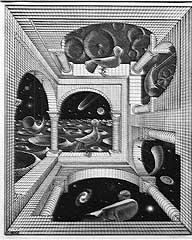
What is peculiar in these assertions is the notion that 'pre- holographic' cultural production was conducted in profound ignorance of the "plasticity of space" or that all pre- holographic work was essentially based on Renaissance visual theory. I have included several graphics from M.C. Escher (one of many possible examples) to suggest some problems with this view. We may recall that plasticity of image space, the condition where several images occupy the same 'space' or where perspective is synthetically altered was evident many generations ago with the invention of parabolic mirrors, lenses and imaging technologies. Also, such 'non- revolutionary' examples of virtual images occupying the same 'space' in Disneyland's "Haunted House" exhibit may serve to remind us that claims for a paradigmatic shift of revolutionary proportions should be based on a cultural perspective that acknowledges the existence of precedent and conceptual innovation not directly tied to technical inventions or visual gimmickry.
My point is that excursions into theory by holographic enthusiasts are riddled with problems that feature the reduction of history or make claims for the importance of a new medium on the basis of near- metaphysical assertions. For what is notable in the emergence of the "hologrammatical culture" and its fixations on symmetries and identities is that these 'new age' conceptions really reproduce many of the traditional, if not archaic, forms of mystical experience and symbolism. "Holosphericity" and "harmonics" are rather classic and ancient conceptions; the identities between "macrocosm" and "microcosm"' between 'part' and 'whole', or 'matter' and 'anti-matter' are equally classic (alchemical) conceptions of life and creation. Unterseher and Schlesinger explicitly posit the theoretical pre-requisites for a "universal coherent background wave (which) might be indistinguishable from the void of empty space". In so doing, one might ask are they also positing a universal pre-existent that would enable all matter to be perceived in terms of an 'absolute' reference wave.
If so, then the 'creationist' aspect of their theory assumes a neo-alchemical assumption concerning transcendental reality. Furthermore, are they also positing an all pervasive condition as both origin and end (as unified and constant state) in the following postulate (p. 363): "Energy filling all of space, of necessity, forms interference patterns, and out of this all pervasive condition, matter is instantaneously formed " (my emphasis). Perhaps the 'holo- spherical' theories of the 'hologrammatical society' are not intending to duplicate classic alchemy. Nevertheless, it is surprising that much of their theorizing invokes the same metaphysic and the same predisposition to transcendental symmetries and binarisms.
The question of 'use value' for a theory of "holocosmology" is difficult to resolve for much of its hypotheses involve the changing nature of physics and knowledge. This does not mean that its present formulations are beyond criticism. Rather, it will be on the basis of criticism and redefinition that such a theory may be deemed 'useful' in the future, if not in the present. In criticism, I would posit that theorizing in the transcendental register produces the condition that, once the basic rules or symmetries are agreed upon, then formal play of signs or aesthetic gestures can occur almost ' et random within this schema, since everything is to be referenced back to the primordial or idealized conception which is the ultimate combinational principle(s). The formalism of the hologrammatical kind (and its 'revolutionary' intentions) is suggestive of a free exchange of images or signs occurring at the level of unconscious dream work, all of which arise on the basis of "wish" and an ultimately referential cause. The formal register thus is only connected to the substantive (content) register on the basis of agreed upon symbologies and their meanings. At the substantive level, the hologrammatical/holospherical is grounded in a conception of basic symmetries, harmonics and patternings which ultimately allude to the twin origins of matter. Here, we could say "art is art", as well as "art is the universe", or "art is...anything, anyplace, anytime...' But what is outside of its particularized scientific cultural schema is another matter. For ultimately it cannot address questions which are not within its conception of culture and language or society for that matter. Its present limits therefore approximate those mentioned in the example of the "scientific theory of art holography" (5.). And while we need not argue that spatial representation in holography is 'different' from that found in other mediums or other historical epochs, I hope that the term "space", as encoded in physics, in art, in holography and its various cultures, is clearly noted by the reader as that very abstraction which requires understanding at the level of cultural, philosophical and scientific reading. "New Space" for some may be simply "old space" for others, and it is usually a cultural context that provides clues as to its meaning and usage.
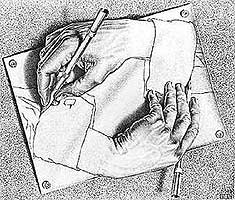
6.1 Subjectivity and Apperception
The artist as perceptual agent finds him/herself influenced by apperception (the understanding of something as perceived in terms of previous experience), structuration and the demands (or limitations) of expression within all medias, and this condition finds a unique and interesting context in holography. (For the purpose of brevity, we need not explore the physiology and psychology of perception, nor the questions which address specific cultural codes of representation, as arising in earlier mediums.)
The holographic artist 'understands something' of a different kind when working in holography: the malleability of space, principles of inverting it or making it co-present with other 'spaces', plasticity and dimensionality of light. Hence, the artist's perception of natural phenomenon, or graphic and sculptural art works, will be subject to a rereading and translation which may or may not result in the kinds of transformations which he/she is able to demonstrate in the holographic work itself. For example, many holographers have a difficulty in relating to flat graphic 'space' (and its implied perspective) in the same manner as non-holographers, and this 'difficulty' may be the primary impetus for the various aesthetic inventions which are conducted on the basis of a new-found holographic sensibility (as holographic apperception).
Apperception, within the holographic medium, becomes a very special and coded property through which and by which we must read the intentionality of the work.
Structuration (intellectual, perceptual and cultural) are limitations which the artist works within and against. Such cultural conventions as 'framing the work' or determining the boundaries of installation and its duration, tied to intellectual and perceptual/physical limitations (and emotional pre- disposition) will effect compromise on the work. Yet to achieve communication in the social context requires structuration. Furthermore, structuration is a coded phenomenon which is the result of integrating many divergent styles as a 'school' or type and as such provides a channel for communicating expressive generalities.
The artistic endeavor implies not only recreation of existing formulations, but also inventions of process, approaches, formal strategies and substantive ideas, and these inventions are externalized as a 'gesture' performed for an audience (which may or may not recognize the inventions for what they are.) Invention implies the presence of ambiguity. If inventions are conducted on the basis of chance orderings (aleatory) then one could assume that the number of possible readings would be maximum. Conversely, a highly structured invention would allow for a narrow range of readings (all others being the result of chance correspondences).
The reason I bring these factors forward is to identify the kind of battle that occurs within cultural contexts: codes of artistic invention operate in competition with overdetermined codes of cultural representation, precedent and prior acceptance. Aesthetic invention, therefore, becomes an issue of breaking out from structuration and limitation, all the while it employs symbolic commonalities (aesthetic traditions, norms of representation, etc.) which facilitate communication.
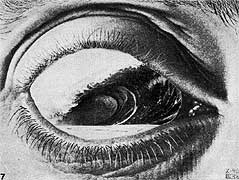
6.2 Aesthetics and Subjectivity; Art and the Fantasmatic
I have discussed earlier the idea that 'space' can be defined in cultural and philosophical terms. It can also be defined in terms of subjectivity where the mind, as a kind of 'tabula rasa', is inscribed with imaginary symbols arising from its own unconscious register - symbols which are externalized in the form of holographic images which assert a kind of 'reality' on the basis of holography to represent three dimensions and time.
Given the capacity of holography to fill or describe a potentially blank/empty space with images/objects or visible traces (limited by wavelength and aperture) there is ample opportunity for the hologram to assume the status of concrete analog to the psychic tabula rasa and to be filled with images that are substitutes or analogs for dream work, mythical and symbolic terms or even 'universal symbols'. The unconscious or mythical dream register is typically the self referential subject matter made manifest in works which are preoccupied with internal psychic processes. Once again, the image vocabulary may range from the idiosyncratic to the collectively symbolic (the mandala, Oroboros, phoenix, crystal, the perfect forms, etc.). Ultimately, the language of the inner self is preoccupied with itself (identity) and the relationship of the 'self' to a totality: Reality, the Universe, God, Society (in the abstract), or abstractions of the self, or negations of the self (as 'Other'). Thus, the apperception of a self-in- isolation, as autonomous self, becomes a process of playing off the various personifications or symbolic substitutes within a general schema of controlled (symmetrical or rule-bound - e.g. religious) structure. When control is lost, when all rules vanish, then we have what might be observed as psychotic or schizoid images which perpetually offer the infinite exchange of representations, all of which are causally detached from meaning (as perceived) and subject to endless proliferation and 'splitting'.
The 'fantasmatic', that which is dominated by the narcissistic self, hopelessly enamored with, or alternatively threatened by, its 'other', is the domain that also includes the dream-like consciousness that cannot differentiate between itself and reality, cannot comprehend language or analysis and is trapped within the binarism of introjective and projective identification with good/bad extremes and their superheroes/supervillains. Within this fantasmatic, as within dream, great feats of image production are possible and great intensities are generated/experienced (as hallucination). The visual field of the fantasmatic is dominated by vivid, intense and brilliant colours, intense sensory experience, all of which tend to function in relative independence of causal meaning or logic. Its relationship to some holographic enterprises is indeed interesting, for holography offers on the basis of 'concretizing' space and producing intense visual fields (the white-light transmissions are an example) some analogous conditions for re-presenting the fantasmatic. Consider Ed Bush's description (Handbook, p. 340) in terms of the fantasmatic and dream process: "Shapes can be twisted at will. Objects can lose their solidity, drifting through one another with unnatural ease. Sudden appearances and disappearances are com monplace and perfectly acceptable, in contrast to the rational world where such inconsistencies are often dismissed defensively by the perceiver." It reads (as a description of holographic "art") very much like a description of the unconscious dream process and the fantasmatic! [he resemblance of this description to one of computational video graphics (seen in logos and 'hightech' ads) is also to be noted, for upon that basis one could see a profound congruence between aspects of holography and our narcissistic audio- visual media culture.
Valuation of unconscious dream work or narcissistic modes of identification is difficult since activation, synthesis and 'invention' are occurring all the time! The art of the fantasmatic is inventive insofar as it recreates its own apperceptual world and symbolic orderings. However, to confuse this art with historical de w lopments (traditions of represensation) is to commit critical fraud doubly over, for it is to confuse "subjective space" with "inter- subjective space" (I hesitate to use the term "objective"). Hence, its "revolutionary" status is largely derived from rhetorical posturings which ignore revolutions in sociohistorical contexts.
7. Theorizing Holographic Art in the Social Realm
I am going to leave the subjectivist position and its cosmic networking for a moment and focus on the practice of holographic art in the social environment, in history, in a world of political and economic forces, in a world of communication and visual signification.
There are two conditions that I must impose on this theorizing (again, it is my prerogative): first, I will background (though never dismiss or suppress) the individual's contribution to the development of social aesthetics for the purpose of identifying more directly macro- groupings of signification/aesthetics; and secondly, I will theorize from a perspective that examines mediation (as structuration) as it occurs in visual expression. In so doing, I hope to avoid the phenomenological trap which posits continuity between reality and perception and the trap of singularizing reality within a given and achieved holocosmology.
The theory of holographic 'mimeticism' (discussed in Part I) is inadequate for the purposes of explaining how ideas enter into representation and interpretation, for mimeticism ultimately reflects on the condition whereby an image 'stands for' something else, namely its 'object'. (These limitations unfortunately were not made clear in Part I.) Instead of a theory which was limited to discussing the holographic image in terms of its 'referentiality' (and whether the image is referential to the object via cultural codes or perceptual codes), it would be advisable to consider the manner in which ideas are generated on the basis of communication within a larger nexus of coded socio-historical contexts. In semiotics, the notion of the production of ideas is found within a theory of "interpretants" (discussed in Eco's text, p. 70) Here, on the basis of denotation, connotation, or inference, or even chance correspondence, an image can be interpreted (by a viewer) as an "idea" (as meaning). This process implies the existence of language, or symbolic orders, and social conventions all of which may contribute to the creation of a shared semantics base which is necessary for inter-subjective communication to take place.
The notion of interpretants is useful when we consider how a holographic image signifies a message/content that involves a multiplicity of ideational meanings: aesthetic meaning, historical, perceptual, a meaning which reflects the time and place of the image, economic and political concerns, the artistic 'personal' (as idea), and other ideational indexes which reveal the manner in which the art is featured in cultural exchange (bought/sold, unique or mass produced?). Inevitably the kind of communication and generation of ideas (as interpretations of the image) involves not only the communication of meaning but also a 'consensus' between artist and viewer, a consensus that f eatures the copresence of 'material' considerations (those listed above) and more idealist formulations (which tend to isolate the formal/substantive from the more widely shared ( social ).
Interpretants are as much a function of changing linguistic and social forms as they are a function of invention (the capacity of an art work to generate unique ideas which alter our perception of ourselves, the manner in which we conceptualize ourselves and the world around us). Whereas inventions can be carried forth on the basis of unique combinational gestures (the formalist preoccupation), they can also feature the introduction of new ideas on the basis of shifts in paradigm or the input of new/unique meaning/content. For the purpose of schematizing the 'aesthetic labor' let us posit (after Eco) that it involves the manipulation of expression w ith the result that content will be reassessed, codes will be changed or new ones will be produced, and the aesthetic labor will produce a "new type of awareness about the world" (as idea which modifies future awareness as well). In that sense, the aesthetic labor is not one of reproducing reality but changing how we experience and perceive art and how those changes influence our perception of both art and reality. (We can probably recall at least once in our lives when our apperception was altered by looking at a specific art work, or reading a literary text, or hearing music - experiences which resulted in us seeing things 'in a different and more profound manner.)
One of the operating phrases in the above is "new type of awareness about the world", and it is precisely on that point that we should acknowledge the difference between aesthetic labors that produce new types of awareness only in terms of their closed and idealized notions of "world" or "cosmos" and aesthetic labors that engage a vision of a social world, which is more closely connected with political and social realities such as those we read about daily. If it is possible to create ideas on the basis of visual representation, then one must conclude that it is equally possible to create both aesthetic and social ideas on the basis of visual representation.
The division between aesthetics and politics has always been arbitrary in that it leads directly to a theory of practice and interpretation that is both discriminatory and unnecessary.
7.1 Theory of the Lie
When we consider the holographic work as aesthetic labor (embodying re-presentation, code transformation and invention), implicit in this conception is the notion that the artist can demonstrate 'truth' or 'falsehoods' which reveal intent, historical and social predisposition as well as philosophy. For the artistic gesture is one that features the measuring of the experience of the art as noted within the rhetoric of the art. Every act of signification and production of meaning necessarily includes both intentionality and rhetoric, for there is no art that is 'given' and 'achieved' and there is no art that does not attempt to persuade the viewer as to the veracity of its propositions (and rhetoric is the domain of persuasion).
Let's use an example in which we are presented with a laser transmission hologram by an artist in 1985 which features a virtual image of a cube, and we are told that this is an original art work. Questions such as, who actually produced this image, who designed and constructed the image technology, where did the idea for this piece come f rom (are there precedents? in holography? in other visual arts?), is this an original intent? Is this image related to other holographic images? Is it 'more beautiful' than any other we have seen? All of the above questions are (also) semiotic questions, for they attempt to identify the way in which we viewers interpret, and understand, the meaning of the image (as signification) and the manner in which the image formalizes and conveys meaning. They may also be moral questions, but within any theory of meaning there is also a theory of the lie (and its corollary, a theory of truth) which identifies the manner in which ideas are generated (and the manner in which representations are made and interpreted).
Within an aesthetic theory (one which allows for rhetoric as well) there would be little need to even worry about truth or deception were it not for the existence of the social (the inter-personal) for it is at that level that a semiotics of truthfulness has applications and it is at the level of culture and civilization that moral and ethical questions find their most evident meaning.

7.2 F is for Forgery
I would like to present a hypothetical situation concerning a hypothetical artist and 'his career' for the purpose of invoking questions concerning the capacity of criticism to identify whether an art work is 'genuine' (thereby valued) or 'fraudulent' (thereby a product of misrepresentation). This example is actually not that far-fetched (but it is not meant to reflect specifically on any one individual).
My example reads: a potential artist discovers the medium of holography on the basis of some pieces that he has seen in an exhibition. The artist is inspired to create some works within the medium. Shortly thereafter, he hustles some money, purchases equipment and technical textbooks, takes a course or two in technique, reads up on what is happening in the arts, who is doing what, reviews a bit of art history, and then produces some objects or scenes which he attempts to make holograms of. His poor results suggest to him that he should take his objects and scenes to a holographic lab where (for a small fortune) the objects and scenes are holographically reproduced in a variety of forms: laser transmission, reflection, white light transmission, integral, dichromate reflection, pulsed transmission and pulsed imageplane reflection.
Our hypothetical artist is still dissatisfied: he wants it bigger, brighter, more complex, and after another session at the drawing board, and after pouring over more art history and issues of "Holosphere", and more dollars, he returns to the lab and finally obtains a series of 'state of the art' large format holograms, which by now feature complex colour work and even come with pre-fabricated installation packages! His career takes off like a rocket! There is even a write up in "Holosphere" and numerous invitations to international exhibitions! f is for fame!
And then...someone else comes along, gets inspired by his work, steals his 'ideas', and mass produces them in embossed form for the cover of journals, for stickers, for corn flakes give-aways. Now the artist screams bloody murder. F is for forgery!
The questions to you, the art critic, are:is the original artist committing forgery, or is only the second one guilty? What is the nature of their respective aesthetic labors? What are the inventions and the production of a new type of awareness 'about the world'? Are there other influences, 'already made' that we have overlooked? What signature(s) should be on the art work? Everyone? Or no one? Who made up the image idea in the f irst place? Is there a history? Does the work reflect on it? Does it matter? If not, are we critics content to let this one slide by and perhaps refer only to that work which excites us "personally"? Besides, if it is good, or seems to be "exciting", do these critical questions really matter? (You be the judge.)
7.3 Critical questions: Art and Ideology in an Age of Crisis
We are now in the '80 s, and the show-business atmosphere of the '70s, along with its circus of instant holo- entrepreneurs who sought to exploit the novelty of the medium for short term gains and instant stardom - the circus that presented the LASER and "Laser Art" as something mystical and all- powerful, and tied to a utopian view of the future in the hands of a select number of enlightened technocrats, is behind us. Right? I would think: 'wrong'.
While we may struggle to better articulate the various competing theories of holographic art in the '80 s, we are also beset by holographic art as 'big business' and mass- production of a range of stupef ying image banalities which would make even our aesthetic pioneers roll their eyes (not to mention Hiltan Kramer). This is the decade of narcissism competing with political change, but the ideology of consumerism and mass communications tends to favor the narcissism, since it is here that the perfect 'consumer' (the narcissist) can be created and simultaneously exploited. This is also the age of militarism and autocracy, where large scale decisions are made by the few, and with awesome implications.
It is not uncommon to find holography promoted along with optical illusions, commercial f il m/video special ef f ects, science fiction, and advertising (and this was the context that the "art of holography" was presented in the August 1983 issues of "Creative Review", a U.K. publication.) The contemporary context for holographic art seems to be the one which f eatures art as tied to spectacle, technical trickery and upwardly mobile lifestyles (with their embossed credit card holograms) and their 'new age philosophy'. 'The rest of the world be damned' this medium, and its ideological allies, seem to be saying.
If holographic art assumes the status of embellishing existing ideologies and lifestyles, as decoration for a culture dominated by narcissism, then it can lay no claims for 'avant-garde' interests in opposing, changing and producing radical alternatives to cultural and political f ormations. For it is precisely on account of an oppositional stance that any avant- garde (in any time period) has achieved any legitimacy.
Holographic art that is founded on the notion of 'precious object' to be bought and sold (by the wealthy) shows its complicity with those very economic infrastructures. Conversely, the mass- produced kitch images are perfectly suitable to a formal narcissism (now you see it now you don't) that trades on 'imaginary'(read fantasmatic) illusionism of possession.
But a larger problem looms: the prospects that holographic art be conducted in complicity with ideologies of domination, militarism, cultural hegemony and technological utopianism (based on identif ying technological progress with cultural progress towards an idealized future). It is here that it might find itself in the company of Ronald Reagan's STAR WARS and George Lucas' same, featuring laser demolition derbys, special effects, and a mystical conception of good and evil. It is here that it would find itself in the company of age-old ideologies of domination/destiny and old philosophies of 'supreme beings', which dress themselves up in contemporary high-tech garbs (and where "Laserium" is both a diversion and a military fact, and where holographic art is selling the 'beauty' of technocracy and hegemony. )
As I posited earlier in my essay, a holographic formalism that is obsessed with mysticism and enhanced by the newest technologies is precisely that kind of art that is most readily transformable to other designs and other purposes. Mystical speculations concerning some hypothetical reality cannot provide clues as to the functioning of this world. Such mystical formalisms are appropriate to 'mythic ideologies' which treat history and fact as 'raw material' for illusory transformation, from material base to mythic language. It is notable that the ideology that produces mythic constructs (reality as fiction, for all time) is reliant on the spectacle to demonstrate the superiority of a particular science and a particular sociopolitical-economic system over all others. Such terms as "superpower" are ideal descriptors for a socio-cultural framework that is informed by the 'power' and 'wisdom' of technology. ("May the Force be with you.' - George Lucas. )
The development of a "theory of art holography" must necessarily engage questions of socio-economic and political nature, for the "awareness about the world" in this day and age of crisis and political upheavals is an awareness about crisis and political formations. This is not to say that aesthetics is a secondary issue, for it concerns the 'speaking' of the message and its experience/form. It is now, more than ever, imperative that formal questions be integrated with social concerns. It is also here, within this integration, that a potential dialogue between science and art can find one of its most productive forms.
Whether art can change anything has been the subject of endless debates, and this issue will be brought forward again if holographic art chooses to concern itself with social change. It is unthinkable that holography as an art form could conduct itself in a manner which ignored its relationship to the very technology that it employs, to the very sciences that it relies on, or to the very society and world with which it attempts to communicate. Failing that, there are many black holes that holography could crawl into as another formalism of the postmodern era.
The reader is invited to comment and/or challenge issues raised
by the author.
-- Al Razutis
1985
Art and Holography Part 1 by Al Razutis 1985
Art and Holography Part 3 by Al Razutis 2020
An Avant-Garde for Holography by Al Razutis